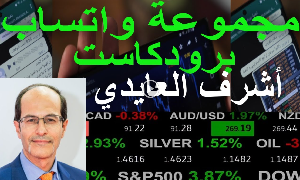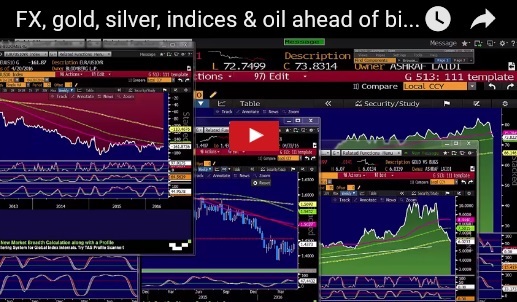Intraday Market Thoughts Archives
Displaying results for week of Apr 17, 2016Central Bank Support To Fade
Mario Draghi asked for patience in a signal that the latest round of easing might be done. Markets continued the trend of punishing volatility as the euro jumped and then dropped. Japanese manufacturing PMI is next. 2 new trades were issued ahead of the ECB, both of which are now in progress, bringing the total of open trades to 7. There are 2 trades in CAD, so tomorrow's Canada CPI and retail sales will be key. The technical and fundamental rationale for the combined trades is shared in our English and Arabic videos from earlier this week.
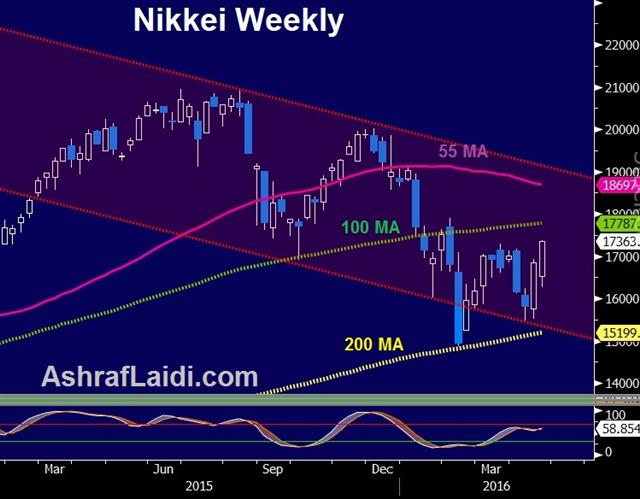
Rate cuts in Europe, China and Japan were the story in the first quarter of the year, along with the Fed rushing to the sidelines. The moves, which may have been coordinated at the G20 in Shanghai, have had the desired effect. Risk assets recovered, commodities climbed and financial conditions improved.
Draghi gave himself a pat on the back at the ECB press conference, saying the March actions helped to shore up the economy. He touted better financial conditions and reiterated that inflation could fall into negative territory but will rise late in the year. It's clear that baring any major changes in markets, he has no plans to ease further.
That type of outlook is likely to spread. The doves will be less dovish and the moderates will shift hawkishly, especially if oil can hold onto this week's surprising gains. Next week is shaping up to be a big test. The Fed may try to re-establish credibility by emphasizing a high likelihood of rate hikes this year. The BOJ would be justified in doing more but if Kuroda also preaches patience it will solidify the wait-and-see theme from the ECB.
The paradox is that risk assets aren't likely to embrace the lack of a helping hand from central banks. Earnings have been mediocre at best so far in Q1. After the bell on Thursday, Microsoft, Google, Visa and Starbucks all missed. It may unfold that central bankers were tricked into believing economies, commodities and inflation aren't as solid as they seem.
In the hours ahead the BOJ will get more data to help them decide what to do next week. At 0200 GMT the April Nikkei Japan PMI is forecast to rise to 49.5 from 49.1. At 0430 GMT, the Feb tertiary industry index is expected down 0.5%.
| Act | Exp | Prev | GMT |
|---|---|---|---|
| Nikkei PMI Manufacturing (APR) [P] | |||
| 49.1 | Apr 22 1:00 | ||
| Eurozone Markit PMI Composite (APR) [P] | |||
| 53.2 | 53.1 | Apr 22 8:00 | |
| Eurozone Markit PMI Manufacturing (APR) [P] | |||
| 51.8 | 51.6 | Apr 22 8:00 | |
| Eurozone Markit Services PMI (APR) [P] | |||
| 53.3 | 53.1 | Apr 22 8:00 | |
| Tertiary Industry Index (FEB) (m/m) | |||
| 1.5% | Apr 22 4:30 | ||
Dollar Rebounds, ECB Next
The US dollar regained a footing on Wednesday and touched a two-week high versus the yen. The Canadian dollar led the way while Swiss franc lagged. With little on the calendar in Asia-Pacific trading, we take a look at Thursday's ECB decision. A new detailed piece was issued in favour of our existing AUD trade. The latest Premium vide ahead of UK retail sales, ECB & Philly Fed is posted below.
Existing home sales were the lone US economic indicator on the day and they improved to 5.33m, slightly better than the 5.28m consensus. A broader US dollar bid developed and USD/JPY was a beneficiary. The pair rose above last week's high of 109.73 in another early bottoming sign. Talk of BOJ easing next week aided the bid.
Once again oil was in focus as the squeeze higher continued through the May contract expiration. Crude was lower until the US inventory report showed a smaller build that expected and another tick lower in US production. WTI rallied to $44 from $41.60 in the aftermath.
USD/CAD touched another cycle low despite a surprise 2.2% drop in wholesale sales (a 0.4% decline was expected. Later in the day, however, the move largely retraced in a sign that there are few longs in the pair left to force out.
Looking ahead, the main intrigue in the day ahead is the ECB decision and whether Draghi will acknowledge the improved outlook for inflation because of higher commodity prices and better financial conditions.
It's difficult to imagine a scenario where Draghi can completely ignore those factors but he may try to balance it some other way in order to restrain the euro. Part of that will be emphasizing forecasts for year-over-year inflation to fall into negative territory in the coming months before turning higher later in the year.
He could also open the door to rate cuts later. The ECB minutes showed a surprising discussion on whether a deeper cut was appropriate. Theoretical talk about helicopter money and other steps could also be used to contain the currency.
The trade so far this week has been better risk appetite but newsflow outside of the energy market has been light. Beginning with the ECB, the week finishes with a flourish and it may set up some lasting trends.
| Act | Exp | Prev | GMT |
|---|---|---|---|
| Existing Home Sales (MAR) | |||
| 5.33M | 5.30M | 5.07M | Apr 20 14:00 |
Dollar Extends Slide, Oil Strike Ends
A second day of US dollar selling and commodity strength will face a test after the oil strike in Kuwait came to an end. The kiwi was the top performer Tuesday while the yen lagged as US stocks touched the highest since November. Japanese trade data is due later. AUDJPY and CADJPY were both stopped out in the Premium Insights. A new trade is due tonight before the Asia Wednesday session.
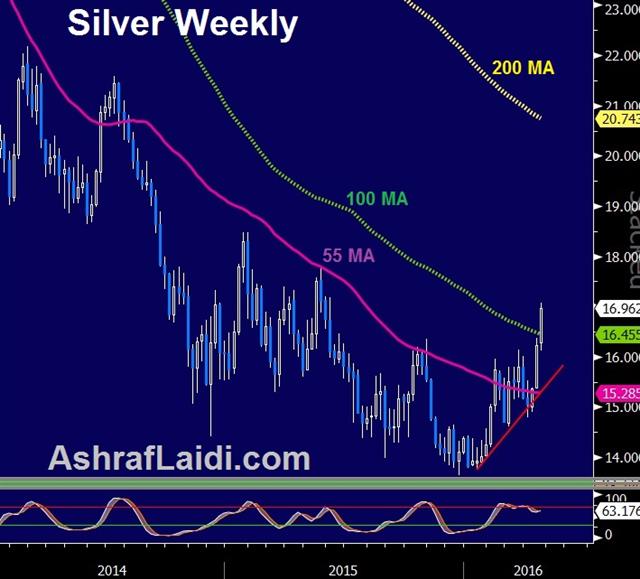
The US dollar was under broad pressure on Tuesday and commodity currencies rallied to cycle highs. Late-breaking news that the Kuwait oil strike has ended and a larger API supply build will challenge that trend in the day ahead.
So far, the resilience of commodities has been impressive. The demand side has solidified since February after central banks took a dovish shift. That same dynamic has underpinned stock markets.
The question is whether it's sustainable. The oil market is no double oversupplied as continued inventory reports underscore. In addition, the signals from Saudi Arabia regarding non-cooperation are clear. Iran also said Tuesday that an increase in exports was only being held back by a temporary lack of ships.
Economic news on the day was focused outside the US. The BOC's Poloz warned that strong Q1 data was likely skewed by inventories, autos and temporary factors. He said there remains plenty of excess capacity in the economy but highlighted that there are no plans to ease further.
The RBA's Stevens refrained from jawboning and said the full effects of easing hadn't hit yet. He also lauded the Chinese economy and the latest steps by the PBOC to stimulate. The Australian dollar hit a 9-month high later largely due to commodities but perhaps due to Stevens as well. However, his lack of jawboning was because he was in New York, not because he's changed his mind about the value of the Aussie.
The first signs Japan may back off plans to raise the consumption tax by 2 points next year also emerged. The policy head of the LDP said they're considering the option of an incremental 1 point hike.
Before long they'll be considering monetizing Japan's debt but in the short term March trade data is in focus at 2350 GMT. A surplus of 843B yen is expected, up from 242B in Feb. We're curious to see how exports have performed after the yen rally. The consensus is for a 7% decline y/y.
The other event to watch is the New York Primary. Trump and Hillary will win by large margins but we'll be tuning in to see if Trump threatens trouble if the Republican nomination is 'stolen' from him.
| Act | Exp | Prev | GMT |
|---|---|---|---|
| Exports (MAR) (y/y) | |||
| -6.9% | -4.0% | Apr 19 23:50 | |
Saudi Squeeze, RBA Minutes Next
A strike in Kuwait delayed the reckoning in oil and other markets on Monday. The pound was the top performer while the US dollar lagged. The Australian dollar touched a 9-month high ahead of the RBA minutes. There are 7 Premium trades currently in progress, 2 of which are in the Aussie ahead of the RBA minutes.
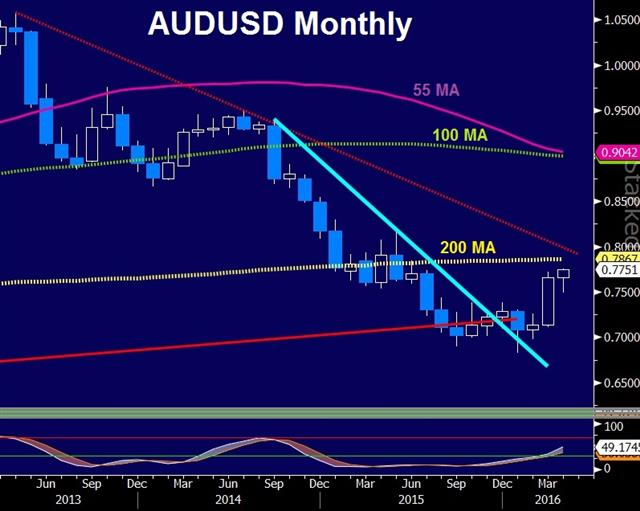
Striking workers in Kuwait lowered production by 1.6 million barrels per day, or more than 60%. In the short-term, that was enough to curb most of the selling from the Doha disaster but it's only a temporary reprieve.
Other attendees in Doha confirmed that Saudi oil minister Al-Naimi switched tactics the morning of the meeting. His shift was likely a directive from the royal family, in particular Mohammed bin Salman who now holds the reigns of Saudi Arabian oil production (and is the defense minister).
For 20 years, Al-Naimi was given a wide latitude to manage Saudi oil based largely on supply-demand dynamics but what happened in Doha suggests he's no longer the main decision-maker. Weekend comments from bin Salman suggest Saudis may be willing to let oil prices fall again in order to squeeze out rivals.
There is no indication of when the Kuwaiti strike will end, although the government has taken a hard line. Ultimately, with no prospects of any future OPEC cooperation and continued oversupply, the path for oil is lower. The bounce today only delays the timing.
In FX, many early moves unwound. A big one was the Australian dollar, which touched a 9-month high in a recovery after gapping lower at the open. The RBA is increasingly frustrated with the currency and that's a point that may be emphasized in the RBA minutes at 0130 GMT.
Stevens has been chided for his frequent verbal intervention but hasn't been dissuaded. Look for commentary from him on the currency and potential rate cuts. Alternatively, stronger economic data may force him to concede defeat, at least for now.
| Act | Exp | Prev | GMT |
|---|---|---|---|
| RBA Meeting's Minutes | |||
| Apr 19 1:30 | |||
No Deal in Doha
Hopes for an oil production freeze agreement in Doha ended in tatters Sunday with leaders walking away empty handed. The breakdown sets up a dramatic start to the week and USD/CAD is already trading up 130 pips. New Zealand CPI is due later. There are currently 5 Premium trades in progress & 1 awaiting fill. 2 of those are in CAD crosses and 1 in JPY.
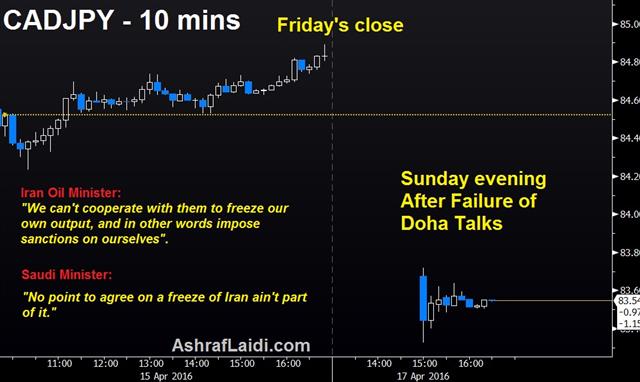
Saudi Arabia took a hard line in what was characterized as a last-minute change in position. They renewed a call for Iran to join the production freeze but Iran didn't even send a decision-maker to the meeting.
Officials tried to broker a face-saving statement but even that failed in what turned into a PR disaster and quite possibly a disaster for oil prices and the budgets of some of the governments who attended. Russia's oil minister said there was a last-minute change in the position of some countries. As a result, he said, the market will take an additional six months to rebalance.
Perhaps the most striking comments of the weekend were from Saudi Price Mohammed bin Salman who said they will sell at any opportunity without a freeze and hinted they could raise production by more than 2 million barrels if they desire. The rhetoric suggests they see a chance to bankrupt rivals and are willing to embark in a price war to make it happen.
WTI slid $1.14 to $40.36 on Friday and it's likely to fall much further in the days ahead. Watch for risk aversion and a jump in yen crosses as the week gets underway.
The lone consequential economic data point is the Q1 New Zealand CPI report. The consensus is for a 0.4% y/y rise and a 0.1% q/q increase. Those numbers clear the way for more RBNZ cuts if they'd like; a downside miss would add some urgency and hurt the kiwi.
Commitments of Traders
Speculative net futures trader positions as of the close on Tuesday. Net short denoted by - long by +.EUR -52K vs -53K prior JPY +66K vs +60K prior GBP -51K vs -47K prior CHF +8K vs +6K prior AUD +35K vs +27K prior CAD +2K vs -0.1K prior NZD +4K vs +3K prior
The yen long is the most extreme since at least 1992.

